Cicadas - Family Cicadidae
This page contains pictures and information about Cicadas that we found in the Brisbane area, Queensland, Australia.

- Largest Cicada in Brisbane, body length over 10 meters, outside Culture Center
Cicadas are familiar in Brisbane because their 'songs' are the back ground noise here in summer. Their empty shells often seen on tree trunks and fences.

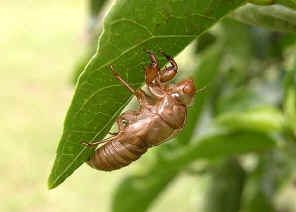
- This is the male who sing the song to attract female. Only the males have the sound producing organ but both male and female have the hearing organ. Each species have different 'songs' which are produced by two organs called timbals on each side of their abdomen. The sound is produced by a mechanism working like the children tin clicker toys. The male cicadas vibrate the membranes by internal muscle and the sound is resonate with the drum-like cavity and this amplify the sound. The songs are primarily for finding mate, but may also for aggregation of males and repel predators.
-
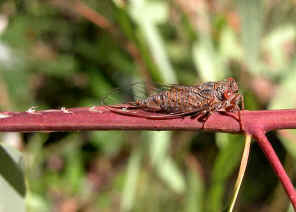
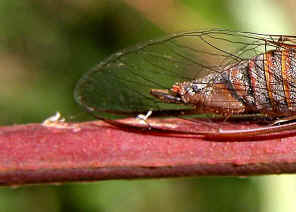
- Female laying eggs on stem.
- Females cut slits in branches by ovipositor and lay eggs inside in group. Nymphs hatch and drop to ground and burrow into soil. They have strong fore legs to move in the soil. The young nymphs live underground suck the roots of trees. Some species have the annual life-cycle and some may live underground for years. There are usually five instars stages.
- Before becoming adults, they come up from soil, have the final moulting and leave those empty shells (above pictures). This usually happen after dusk in summer night. After coming out for soil, they will find any near-by vertical items, usually tree trunks or grass stems, climb up for the moulting.
- From the cicada songs that we heard, Brisbane have much more species than we listed below. We will add more species in every summer. Please come back to our Cicada page from time to time.
Subfamily Cicadinae
- Double Drummer
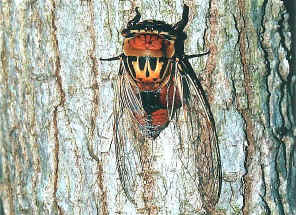
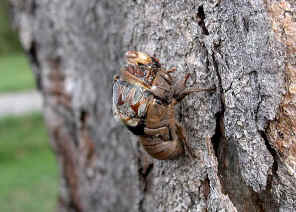
- Thopha saccata, male, body length 45mm
- Double Drummer Cicadas are the largest cicadas in Australia and they make loudest sound. They are brown in colour with black pattern. For the male, on each side of their abdomen there are the small pockets, the double drum, which are used to amplify the sound they produce. Usually they stay high on the tree and make the sound during the summer days. The second picture shows a dead cicada. It was stuck on its last molting.
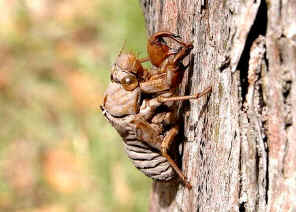
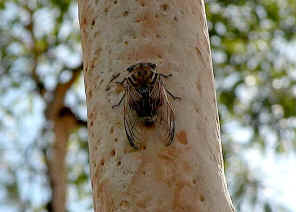
- The Double Drummer product loudest song too. In mid summer, they can be found gather a few meters high on large eucalypt trees.
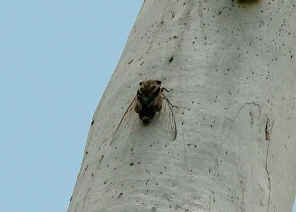
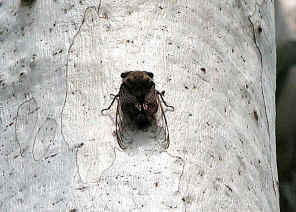
- Clanger
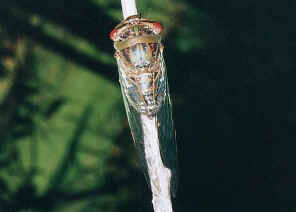

- Psaltoda claripennis, body length 25mm
- The cicada has the colour patterns of green on brown and dark brown. Its eyes is pale red in colour. Its wings are clear with green vein. We sometimes find them in Wishart.
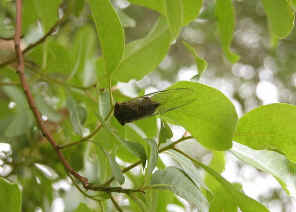
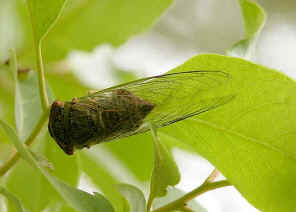
- In mid summer, we found this cicada hiding under leaves during the day in Karawatha Forest..
- White Drummer Cicada

- Arunta perulata, female, body length 40mm
- We found this cicada as dead body in Morton Island in mid summer. This cicada is dark brown in colour with 'W' on centre of thorax. Its abdomen is rather 'floury' look. Wings are clear, with two spots near the tip on each forewing. The top edges of forewings are with green veins which joints with a green line across the thorax. We failed to identify this species because we expected the two white drums for White Drummer Cicada. We forgot female cicada does not have drums. Lindsay Popple advised us by email that " it looks to be a worn female White Drummer Arunta perulata, which is quite common in Banksias and Casuarinas in Morton Island."
- Brown Bunyip
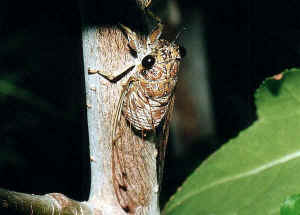
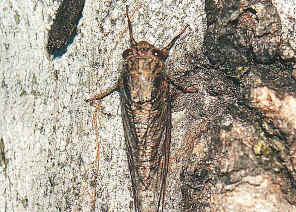
- Tamasa tristigma, male, female, body length 20mm
- Brown Bunyip is one of the most commonly seen cicada in Brisbane. This Cicada is light brown in colour with black pattern on thorax. Across the abdomen there are the black, brown and light brown narrow bands. Wings are clear, males have three dark spots on tips of each forewings. They are found on the Liquidambar trees in our backyard in Eight mile Plains in Brisbane during mid summer. They are small and usually sit on the tree trunks, about two meters from ground. Because they often sit in the shadow, with their camouflaged colour, they are not easily seen. Their song is a long continuous low pitch zeep which may continue for minutes. More information and pictures please click on here.
- Razor Grinder
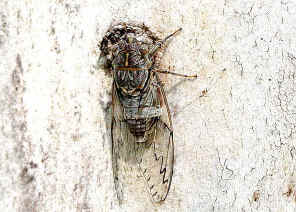
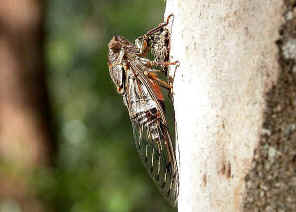
- Henicopsaltria eydouxii, male, body length 40mm
- We found them in Mt Cotton during mid summer. They rest at the lower part of the tall trunk, about 1.5 meters to 3 meters from ground. A few of them can be found singing on the same tree trunk. They produce very loud sound resemble metal grinding. They are dark brown in colour with dark zigzag patterns on front wings veins. The veins near wing edges are also dark in colour. More pictures and information please click on here.
Subfamily Tibicininae
- Bladder Cicada
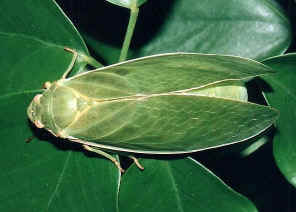
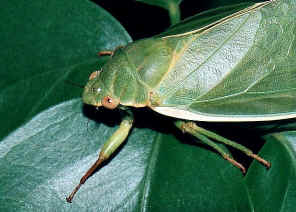
- Cystosoma saundersii. subfamily Tibicininae, male, body Length 50mm
- We found this Bladder Cicada in the front yard of our friend in Nambour, about 100km north from Brisbane. We heard a very loud noise when we arrived our friends house in a summer late evening. At first I thought there was the problem of my car engine. Then we found that the noise was coming from a tree next to us. By carefully inspection, we saw this Bladder Cicada. We brought it home and put in on a tree in our backyard. Now we can hear this loud noise every evening. Unlike other cicadas which always calling during the day, Bladder Cicada only calling for a short while after dark in the evening. They feed on the plants by punching its needle like mouth into the stem and suck the juice. This must be a male because only male cicada will call. It a large, hollow abdomen, which acts as an echo chamber. We have recorded its sound. More details please visit this page.
- Floury Baker
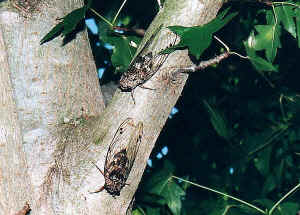
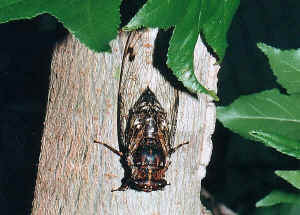
- Abricta curvicosta, sub-family Tibicininae, body length 35mm
- The Floury Baker Cicada is dark brown in colour with lighter brown centre line on thorax. Its abdomen is rather 'floury' look so has its common name. Wings are clean, with two spots near the tip on each forewing. They are very common in Brisbane. Their song start with zeep-zeep-zeep phrases, about one zeep per second when start, then faster and faster until become a long zeep sound. They like to sit on the tree limbs and face downwards while most other cicadas face upwards. We recorded its song as well. More details please visit our Floury Baker page.
- Thin-striped Wattle Cicada
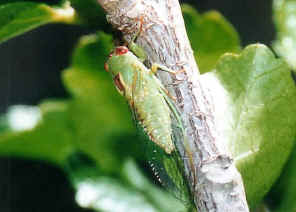

- Cicadetta oldfieldi, sub-family Tibicininae, body length 20mm
- We found a few times those cicadas rest on the Hibiscus in our back yard during early summer. As their name implies, the cicada can also be found on Wattle (Acacia) tree. Their bodies are green in colour, with brown marking on thorax. Their pair of compound eyes and three simple eyes are reddish-brown and outstanding from their green head. Their wings are clear with thin black veins. More pictures and information please click on here.
- Small Bottle Cicada

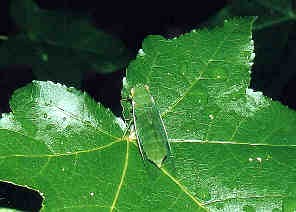
- Chlorocysta congrua, sub-family Tibicininae, body length 20mm
- This cicada is green in colour. Its abdomen is comparatively large. Wings are clear with green veins. We took this picture in Eight Mile Plains on a pine tree trunk on early summer. Sometime we can find them singing in our backyard. When they sing, they only sing for about 4 seconds, and then stop for tens of seconds for another call. More information on the Small Bottle Cicadas page.
- Either Bark Squeaker
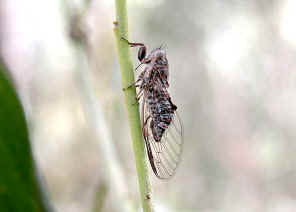
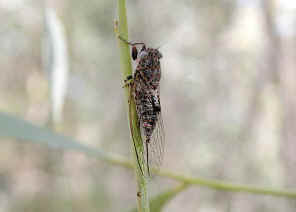
- Pauropsalta fuscata, subfamily Tibicininae, body length 25mm
- We cannot identify this cicada. We took the above photos on mid summer in a Eucalyptus forest near Mt-Cotton. The cicada was at rest on a young Acacia tree. The cicada was quite camera friendly, it let me take a few photos very closely before it flew away. Lindsay Popple sent us email and advised that "it could be either Bark Squeaker Pauropsalta corticinus or Small Bark Squeaker Pauropsalta fuscata. Both occur in the Mt Cotton area. These species do differ slightly in size and also body shape, but it is hard to tell from the photos. They do produce very different calls."
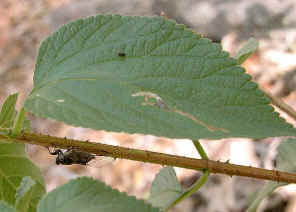
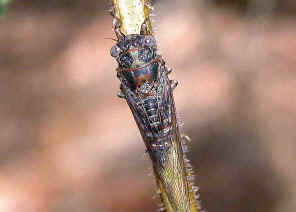
- In Mt Cotton mid summer, we also found many of them on Lantana.
- Small Bark Squeaker
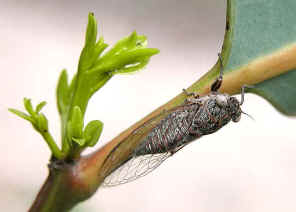
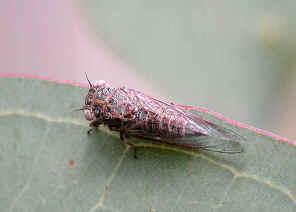
- Pauropsalta corticinus, body length 20mm
- We found this small cicada resting on young gum tree stem in Karawatha Forest on a cloudy summer day. It did not fly away even we tried to catch it.
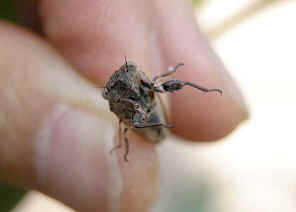
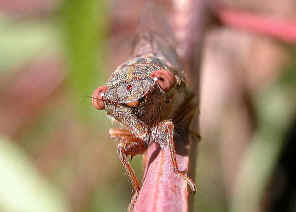
- It flied away and disappeared in mid-air after we took the about photo.

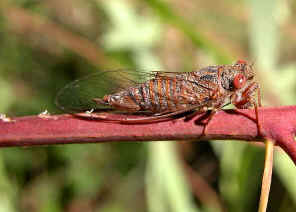
- Female laying eggs on stem. Notice the her ovipositor and the cut marks behind her.
- Cicada found on gun tree trunk

- ? sp.
- Pictures was taken in Karawatha Forest during mid summer.
- Here we like to thank Lindsay Popple for sending us emails and helping to identify some of the species in this web site.
